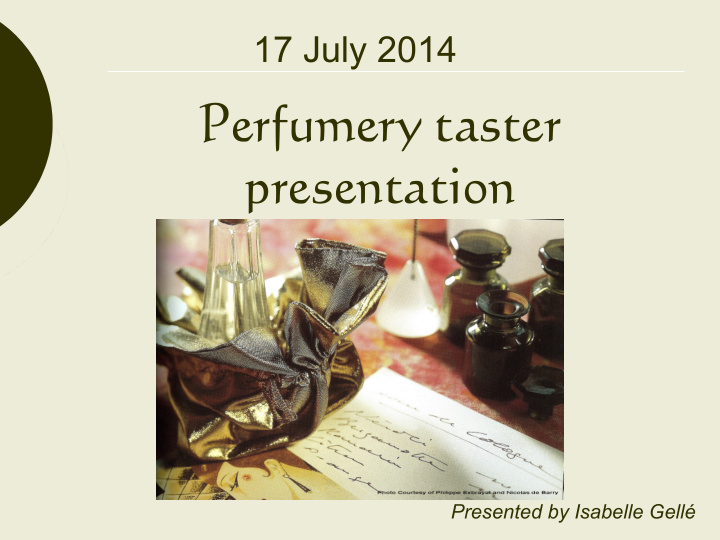



17 July 2014 Perfumery taster presentation Presented by Isabelle Gellé
Today • The ABC of perfumery • What is perfume and what is it made from? • What are perfume families? • Different types of perfumes • How a perfume is structured • Composition of a classic English lavender cologne
The ABC of perfumery A perfume is a picture painted in smells Like music it has notes and tones Like wine the more it macerates, the better it becomes. Like cooking, when you mix the right ingredients, it is delicious! Perfumery is a living art
A bit of history Origin of the word perfume: Latin ‘PER ER FUMEM EM’ => THROUGH SMOKE The first perfume ever known is KYPHI , a blend of myrrh, juniper berry, fenugreek, pistachio, rosemary, mint in the Ancient Egypt. Perfumes were made of resins and fats which, when melted were perfuming the hair and face.
A bit of history Traditional perfumier
Perfume from your kitchen or garden! Tinctures & infusions Maceration of plant materials in oil or alcohol
What is perfume made from? Essential oils isolated from natural plant materials
What is perfume made from? Aroma chemicals – (chemicals with smells) either separated from essential oils or from chemical sources such as the crude oil industry (eg. pinene,benzene)
What is perfume made from? FACTS It takes 4 tons of rose petals to extract 1 kg of rose oil.
What is perfume made from? Animal products – from animal secretions. Replaced by synthetics or natural alternatives due to animal protection rights. Musk deer Civet cat Sperm whale Beaver
What is perfume made from? Ambergris – a stone resulting from the digestive excrements of the sperm whale. One of the most expensive ingredient in perfumery… Gives the AMBER odour. Ambergris found in Madagascar
The perfume families THE RAW MATERIALS ARE CLASSIFIED IN FAMILIES Petitgrain bigarade Algae Vanilla Bergamot (sea mist) Lemon Lemon Moss Oakmoss Birch tar (leather) Geranium Cinnamon Rose Oakmoss Lavender Cedar Lavender
The perfume families ACTIVITY: UNLEASH YOUR SENSE OF SMELL Petitgrain bigarade Algae Vanilla Bergamot (sea mist) Lemon Lemon Moss Oakmoss Birch tar (leather) Geranium Cinnamon Rose Oakmoss Lavender Cedar Lavender
The pyramid of notes EACH NOTE IS PLACED ON A 4 LEVEL PYRAMID TOP NOTES Citrus Fresh, Aromatic citrus Marine ‘Sillage’ Floral HEART NOTES Green The theme of Aromatic the perfume Spices Fruity Modifiers: violet leaf, balsam, benzoin Woody Spicy, Oriental Green, herby Animalic BASE NOTES Powdery Sweet Fixative
The accords THE BLEND OF INDIVIDUAL NOTES CREATES AN ACCORD AND GIVES A NEW ODOUR THE ACCORDS PUT TOGETHER CREATE A PERFUME…
The accords ACTIVITY: CREATE A NEW ODOUR WITH INGREDIENTS FROM YOUR KITCHEN! 3 drops of orange 8 drops of lime 1 drop of cinnamon bark 2 drops of vanilla 2 ml alcohol = ???
Classic English lavender… ENGLISH LAVENDER COLOGNE: INGREDIENTS TOP NOTES Petitgrain Bergamot Lemon HEART Lavender NOTES Lemon verbena Modifiers: Clary sage Oakmoss BASE NOTES Coumarin
The different types of perfumes • Extrait (extract): 30% compound • Eau de Cologne : 8-12% compound • Eau de toilette : 12-20% compound • Eau de parfum: 20-25% compound • Aftershave: 5-8% in alcohol and distilled water or floral water
Enjoy your English cologne!
CONTACT DETAILS WWW.LESPARFUMSISABELLE.CO.UK TEL. 248 2613687 Thank you!
Recommend
More recommend